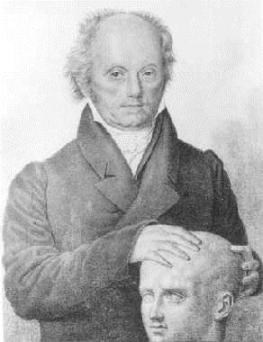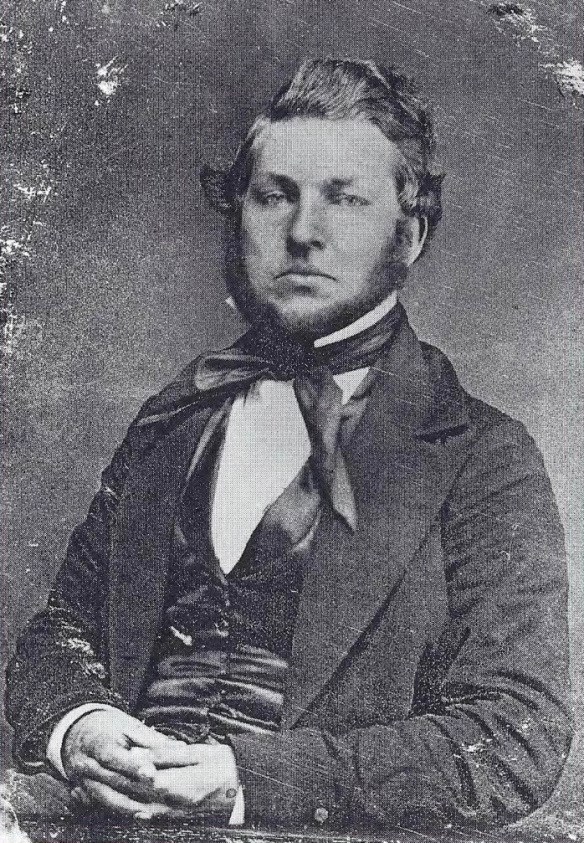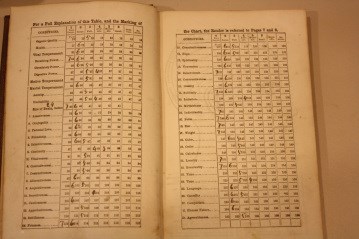Last updated: October 28, 2020
Article
Phrenology in Victorian America

Sidney University, http://www.sidney.edu
Founding Principles
Phrenology was founded by German-born physician Franz Joseph Gall (1758-1828). In 1810 Gall published his principal work The Anatomy and Physiology of the Nervous System in General, and of the Brain in Particular in which he stated the following doctrinal thesis of phrenology:
• That moral and intellectual faculties are innate;
• That their exercise or manifestation depends on organization;
• That the brain is the organ of all the propensities, sentiments and faculties;
• That the brain is composed of as many particular organs as there are propensities, sentiments and faculties which differ essentially from each other;
• That the form of the head or cranium represents the form of the brain, and thus reflects the relative development of the brain organs.
Gall ascribed personality traits such as “Reverence”, “Destructiveness”, “Firmness”, “Mirthfulness”, and “Caution” to specific areas of the brain. If a trait were especially well developed, that area of the brain would be larger, causing a bump in the skull. Likewise, if a trait were underdeveloped, that area of skull would be flat or possibly compressed. Phrenologists hypothesized that by palpating one’s head they could identify one’s parental aptitude, artistic talent, intelligence, propensity to crime, and other mental and moral faculties.

wikipedia.com
Acceptance in Victorian America
Phrenology asserted that the brain, a physical organ, and not the soul, was the center of moral reason and character development. Mainstream Victorian society was offended by and skeptical of any discipline that was not in harmony with religion. Phrenology could not have enjoyed such enormous popularity had it not made the effort to reconcile the dichotomy of God and science. The movement had to place less emphasis on scientific research, and its doctrines had to be in accordance with scripture and the laws of nature.
British phrenologist George Combe (1788-1858) is recognized for popularizing phrenology in America. His classical exposition, The Constitution of Man, served as a guide for conduct and was one of the bestselling books of the nineteenth century. Combe’s treatise promoted naturalism, a philosophy that “nature is all there is and all basic truths are truths of nature.”
Orson Squire Fowler (1809-1887) and his brother Lorenzo Niles Fowler (1811-1896), two of phrenology’s pre-eminent promoters in the United States, are widely credited with cracking the “science vs. religion” paradigm. Both men studied for the ministry before becoming interested in the new science. Their books and lectures on the subject made many references to God and “the truth.” The brothers touted phrenology as a practical tool for self-improvement.

Corbis-Bettman
James A. Garfield and Phrenology
As a student of The Western Reserve Eclectic Institute (now Hiram College), James A. Garfield attended several lectures on phrenology and even debated on the resolution that phrenology was a science – Garfield in the affirmative. In July 1850, the future president attended a lecture on the subject in Chagrin Falls, Ohio. The speaker, Nelson Sizer, was a leading phrenologist in the “Phrenological Cabinet” founded by the Fowler brothers. Four years later, Garfield made a trip to the Fowlers’ establishment in New York. In his diary, dated July 10, 1854, he wrote about the experience:
(I) had my head examined by Mr. Lorenzo N. Fowler. In the main he agreed with others. He said I was inclined to be mentally lazy, and had never called out my powers of mind, that they were greater than I supposed. He told me to elevate my standard of aspiration and thought. I had better aim at the Judge’s Bench. Said I needed to be more spirited in resenting an insult.
During another visit to New York in the summer of 1857, Garfield would again have his head examined by Lorenzo Fowler. In his diary, dated July 28, is a dictation of the diagnosis:
Brain very large – too large. Great amount of vitality. You cannot wear out if you have any regard to physical law. You will not reach your meridian of life and strength till you are 45 years old.
Your strength lies in your general power. The whole of your machinery comes to the help of any one part, thus giving great force. When your intellect is engaged your feelings are too, and when your feelings are engaged so is your intellect.
Remarkable power of accumulating knowledge. Bent of mind for Science but is getting more and more for Literature. In faith you are a Thomas Didymus. Wonderful memory. Ear for music good. Talent for it ordinary. Enjoy fun and make it. Your fun is the offspring of Wit and Fancy.

National Park Service
Have high ideas of worth in Character, a Disposition to do good.
You have a great a great deal of poetic talent. You have a good degree of self esteem. Are very warm hearted. Always had to love something. Should have a wife to keep you in the right place. You have the powers and qualities to be a good general. Your mental grasp equal to any task. Can accomplish whatever you undertake and determine to do. Set your mark as high as it can be placed and then work up to it. You want a wife – refined, genteel, graceful, of a philosophic mind, sharp, lively, sprightly, forehead high and broad.
In the department of Science you would become an Agassiz. The profession of the Law for you should only be a steppingstone to something else higher.
In speaking you need the stimulus of opposition.
There is no other mention of phrenology in the twenty-four years of journal writing that followed this entry. There is evidence, however, that Garfield had at least one more reading. A record of this event, a phrenological chart, is on exhibit at James A. Garfield National Historic Site. The book containing the chart is inscribed by Nelson Sizer and is dated May 14, 1864. Though no diaries exist for this year, Garfield’s letters to family, friends, and colleagues suggest that this was a particularly conflicting time professionally and personally for the young congressman, husband, and father. One can only speculate if Garfield’s phrenological readings had any influence on his future pursuits.

Charles Guiteau
Taken quite seriously by numerous Victorians, phrenology naturally extended to the diagnosis and treatment of criminals and the insane. One such example leads us back to the life, or more appropriately, the death of James A. Garfield.
By 1881, the year the president’s assassin Charles Guiteau was put on trial for murder, interest in phrenology was fading. Nonetheless, the correlation between the physicality of the head and the processes of the mind continued to consume neurologists and psychiatrists. Several physicians who examined the accused were called by the defense to give their expert testimony. Dr. Edward Spitzka gave a lengthy analysis based on what he considered correlative neuroanatomy. Spitzka commented on Guiteau’s cranial asymmetry, but conceded that the difference between the two sides of the brain did not “constitute a diseased difference”.
The “Truth”
Before advancements in the field of science and medicine discredited the claims of phrenology, its reputation was sullied by disreputable people who exploited the “science” for profit, or used its tenets to promote racism. The profound effect it had on Victorian culture cannot be denied. Phrenology played a huge role in motivating, shaping and coloring the minds of some of the era’s greatest thinkers and literary artists and it helped advance the study of human behavior. Perhaps most importantly, it brought to light the need for serious critical analysis in all we accept as “truth.”
Written by Mary Lintern, Park Ranger, James A. Garfield National Historic Site, August 2012 for the Garfield Observer.
